The Seasonic PRIME Titanium PSU (650W, 750W, 850W) Review: Mythical Performance
by E. Fylladitakis on April 7, 2017 9:00 AM ESTCold Test Results
For the testing of PSUs, we are using high precision electronic loads with a maximum power draw of 2700 Watts, a Rigol DS5042M 40 MHz oscilloscope, an Extech 380803 power analyzer, two high precision UNI-T UT-325 digital thermometers, an Extech HD600 SPL meter, a self-designed hotbox and various other bits and parts. For a thorough explanation of our testing methodology and more details on our equipment, please refer to our How We Test PSUs - 2014 Pipeline post.
| Seasonic PRIME Titanium Efficiency (~25ºC Ambient Temperature Testing) |
||||
| % | Titanium Requirements (230AC) |
650TD | 750TD | 850TD |
| 10 | 90% | 93.1% | 93.2% | 92.9% |
| 20 | 94% | 94.2% | 94.2% | 94.1% |
| 50 | 96% | 96.3% | 96.2% | 96.1% |
| 100 | 91% | 94.8% | 94.8% | 94.8% |
We usually expect to see an 80Plus Titanium certified unit to borderline pass or even fail the certification requirements during our testing. This is because we are supplying 230V AC to the unit and most models have been optimized for an 110V AC input, as the certification requirements are significantly lower and makes it slightly easier for the designer to meet them. Seasonic positively surprised us because all three of the new PRIME Titanium units are extremely efficient, easily meeting the stricter 80Plus Titanium performance requirements with an input voltage of 230V AC. The top efficiency of all three units is ~96.2% when operating at 50% capacity, with a nominal load range (20%-100%) efficiency average of 95.1% (650W model) to 95.3% (750W/850W models). The low load efficiency with the PRIME Titanium PSUs operating at 10% capacity is above 84.5%, which is much higher than the peak efficiency many low-cost PSUs can hope to achieve. Still, the efficiency of the units once they reach 20% capacity is so high that the thermal losses actually seem to drop instead of increasing.
Please note that we had the hybrid fan mode disabled during our testing in order to showcase the low load noise levels with the fan turned on. With the hybrid mode turned on, the fan starts when the load reaches about 20-25% of the unit’s rated capacity.
The internal operating temperatures of the Seasonic PRIME Titanium are very low, which is to be expected with such an efficient design. The cooling fan initially appears to have a “ladder” behavior, increasing its speed in steps in relation to the load, but the thermal control circuit is actually linear. When the units are operating in an ambient temperature environment, the speed increases are just very small in relation to the fan’s operating range, which appears as a step-like behavior on a chart. The fan of any of the three units did not even reach 50% of its rated speed at maximum load under these operating conditions, operating way below its optimal range and barely reaching audible sound pressure level figures.
The hybrid fan mode is the only thing that does not make much sense with these three units. If the setting is set to off, the fan will start as soon as the PSU is powered on regardless of the load, but will still retain its minimum possible rotational speed until the thermal control circuit decides that it needs to spin faster. The fans of the PRIME Titanium units are inaudible when running at such low speeds. If the setting is turned on, the fans will start before the point they become audible with the setting turned off, meaning that there is no practical difference at low loads whether the fan is spinning or not. Considering that the fans of the units are inaudible when spinning at their minimum speed, it might be wise to keep the hybrid mode turned off. Lower operating temperatures can only increase the longevity of a PSU, even one as good as this one.


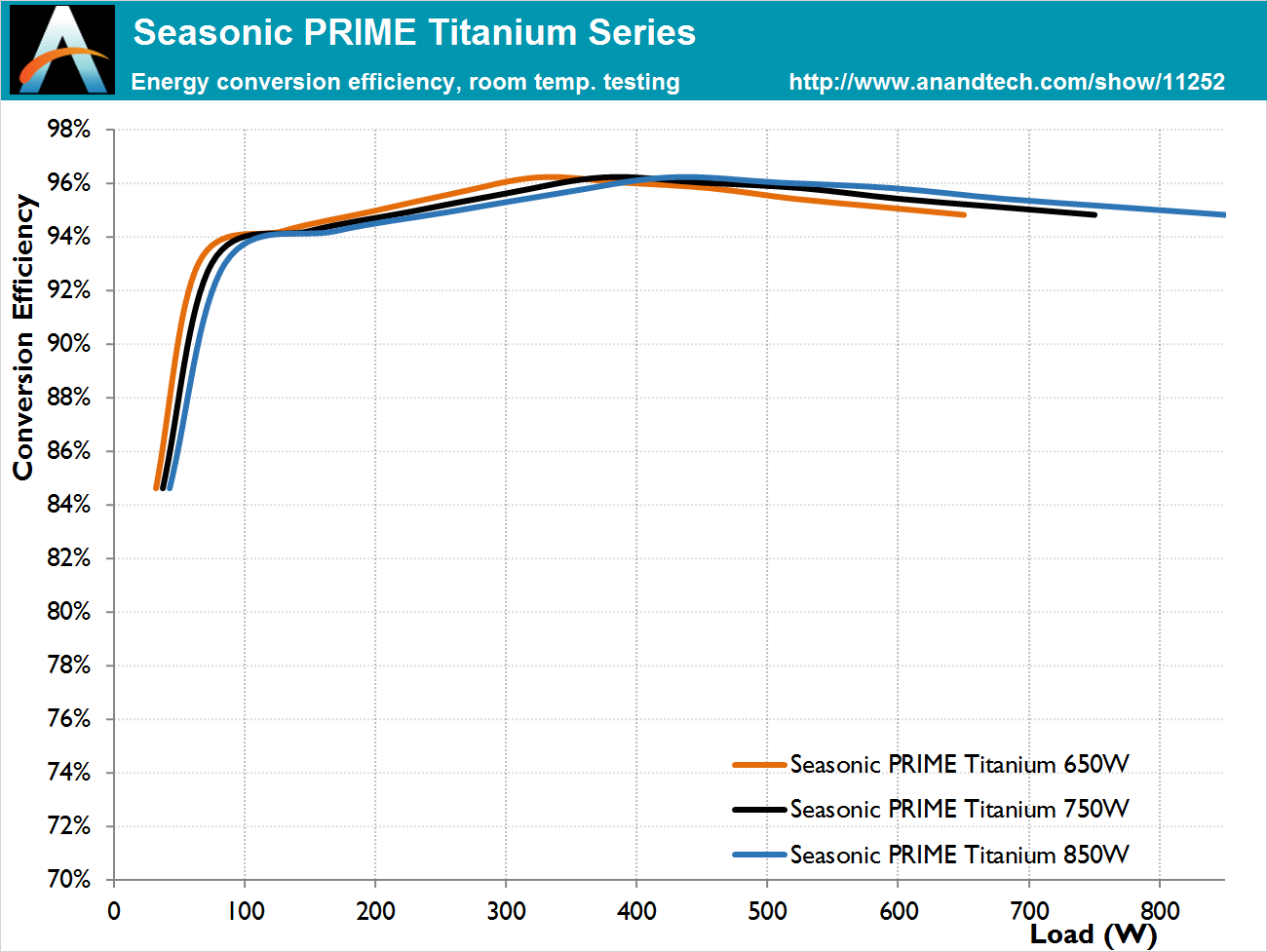
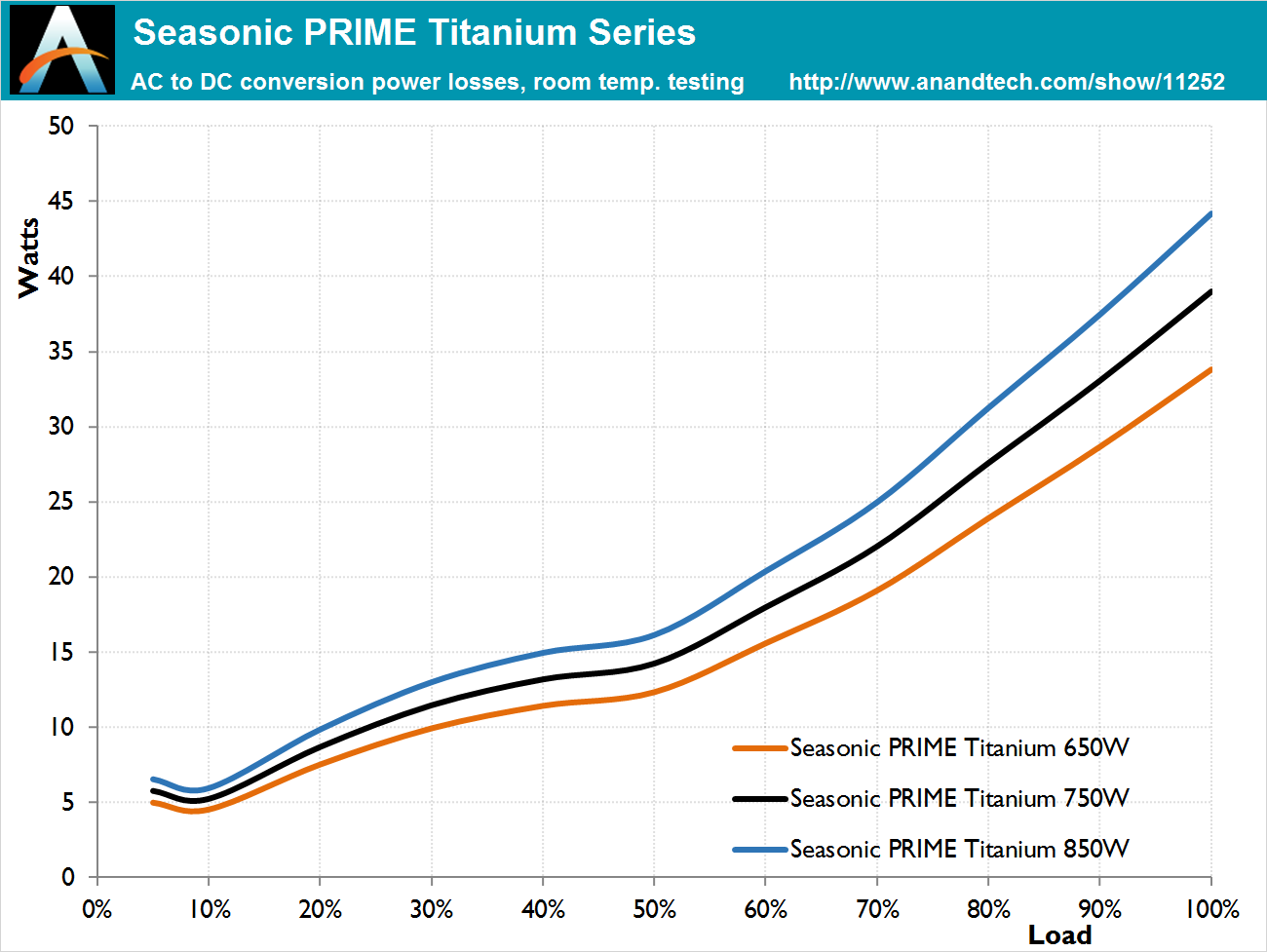
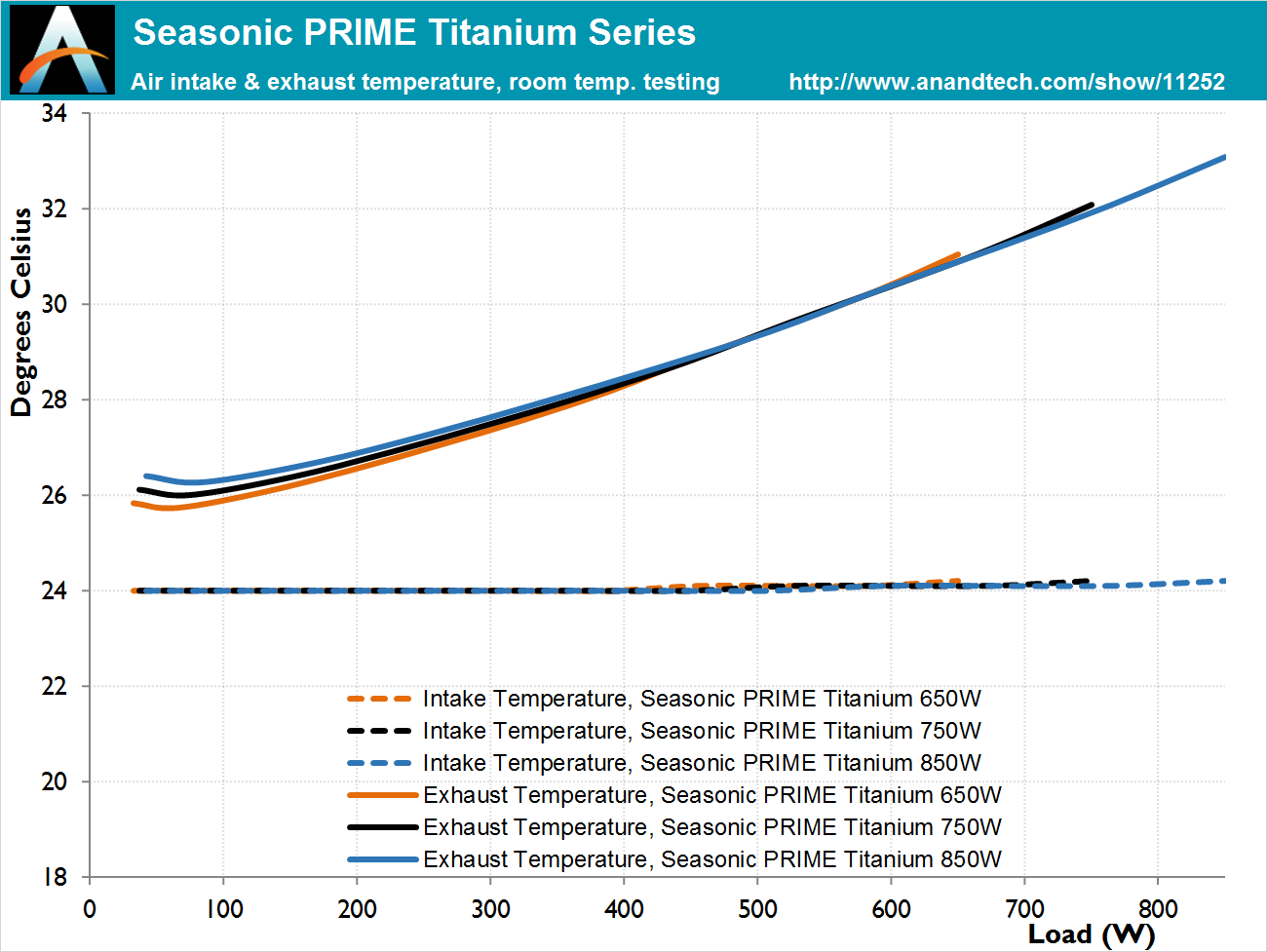
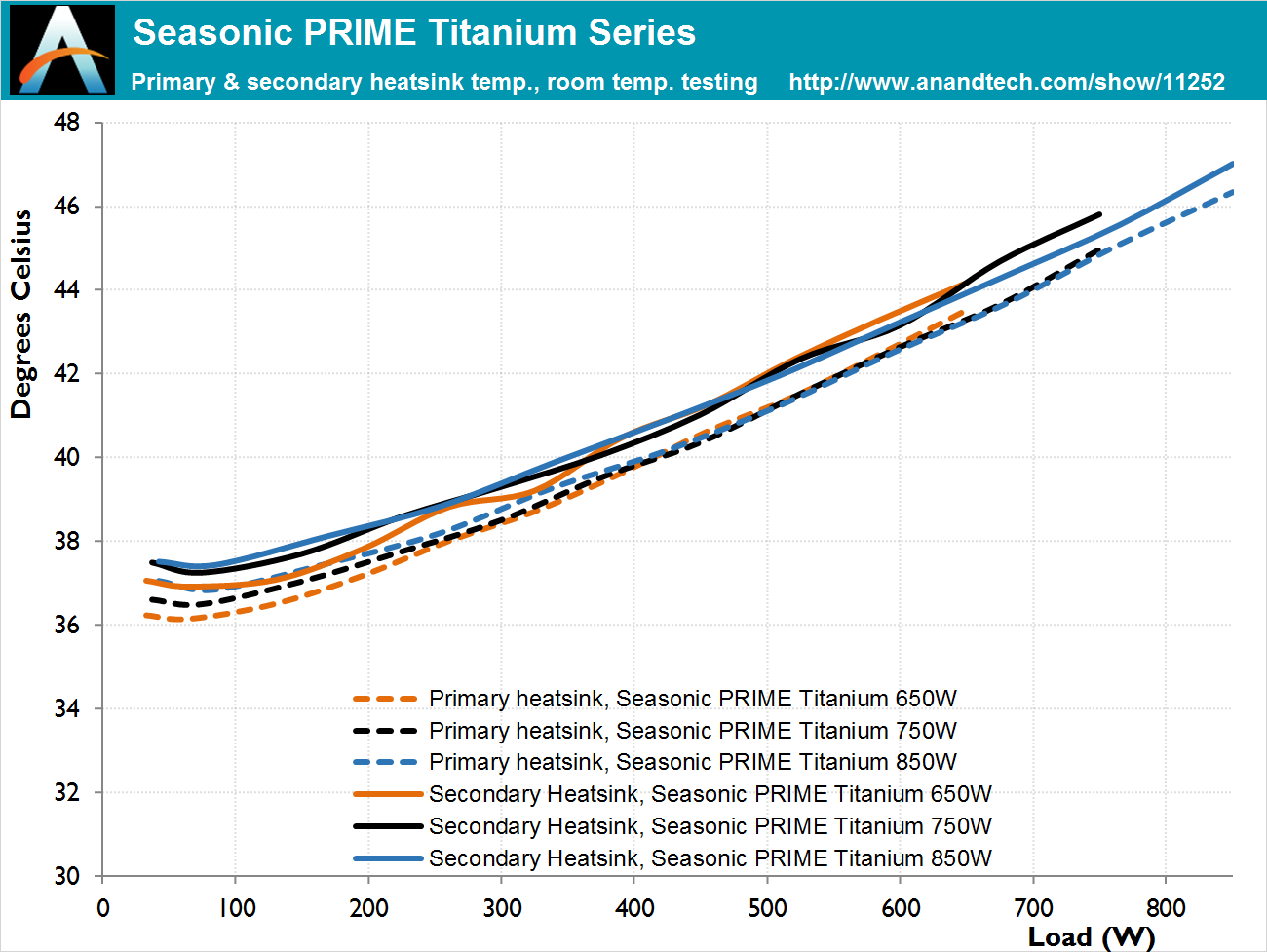
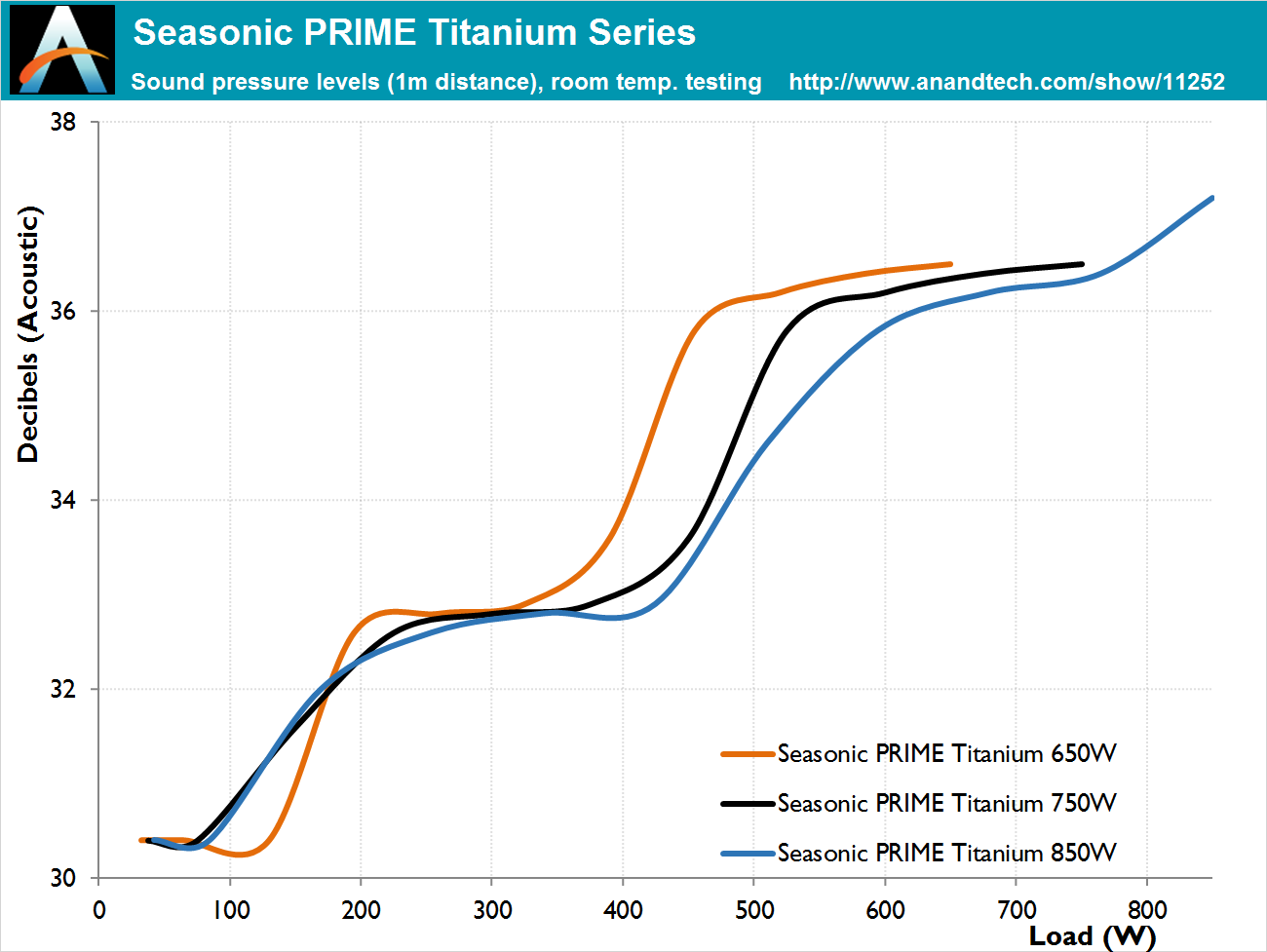








86 Comments
View All Comments
GhostOfAnand - Friday, April 7, 2017 - link
High-efficiency is only one perk. The superlative ripple, transient response, etc of these Seasonic units means you're providing your high-end components with quality power. This means longer life, better stability, and greater over-clocking headroom.A solid PSU is the cornerstone of a proper build done right.
Arbie - Friday, April 7, 2017 - link
Written like a true non-engineer.Kevin G - Friday, April 7, 2017 - link
The price difference would pay for itself in 7 years and considering that this unit has a 12 year warranty, the difference certainly would pay for itself. There are also additional factors to consider if say electrical prices increase. Return on investment would occur sooner under such a scenario.The real challenge is if motherboards continue to adhere to the ATX power spec for another decade. Using this power supply down the road could be challenge in that context. To these models credit, it is fully modular so if an ATX replacement were to arrive without adding any additional voltages (i.e. using only 3.3V, 5V and 12V), then an adapter cable could be created.
These are appear to be excellent units worth the price premium they command.
DanNeely - Friday, April 7, 2017 - link
It's not just the whole ATX standard, but all the stuff around it that would make me leery of planning on more than a half dozenish years from a PSU for deciding if the premium is worth it. We've been ATX for the last 20ish years during which time we've gone from 3.3/5V centric to mix low/high voltage centric, to 12V centric designs. Extra CPU power has gone from 6 pin 3.3/5V to a 4pin 12v to 8 pin 12v. Peripheral connectors have gradually gone from Molex to Sata. GPU power has gone from a 4pin Molex to 6pin to 8 pin. While an older PSU may work with suitable adapters (only the CPU connectors and 3.3/5 vs 12v centric designs are breakers); doing so becomes progressively more of a kludge.JasperJanssen - Saturday, April 8, 2017 - link
Yeah, but there's no reason whatsoever to think that we're going to move away from 12V centric any time soon, or ever. It's possible that we're going to drop legacy rails such as 3.3 and 5 like we did -5/-12 (already mostly gone), but I don't see us moving from 12V centric to 24V centric or 48V centric, even if that would give further efficiency advantages, and I don't think the 12-to-1.1V DC-DC converters are meaningfully less efficient than 24 or 48 to 1.1V -- so the possible gains are mostly in using less copper for the current carrying capacity. I don't see that as enough of a gain to overcome the inertia of the whole industry.Plus, the desktop PC industry is dying anyway, and when you're slowly dying is not usually the time to reinvent whole parts unless that can prevent the slowly dying.
Aslan7 - Monday, April 10, 2017 - link
A friend upgraded their qx6600 systen 3-4 years ago, and I got the guts (MB, CPU, RAM) of the old system. Another friend was retiring a Micron Millennia PIII system from ~1997. I was planning to use the qx6600 guts in the Micron Millennia case, but as I was looking at it, I would have needed a massive number of power adapters to be able to plug things in. I said fine, so what?, but then I looked at the 12V output on the PSU. I was short amps. It wasn't even worth buying the adapters to try it. I threw away the guts of the Micron Millennia including the PSU. In short it's going to be a rare 90's power supply that has enough 12V amps that it would be usable today even with adapters.The Micron Millennia case though, is very well designed. The fans clip in and swing out of the way on hinges, there's fans where they're needed. The drive arrangement is nice, the PSU is mounted on a hinge to make cable routing easier. There's plenty of drive bays. All the proper standoffs are there for a large motherboard. It's a really good case especially being from 1997. The only two issues were the power button quit working about 2 years ago, so I have a power button cable run between the side panel and the case, and the other issue was the standoffs for the motherboard are insanely long. I had to special order those so that I had enough to support my large motherboard.
I run a number of personal systems 24/7 doing various tasks for me and while idle performing computations for WorldCommunityGrid.org (curing cancer and such) My main system was powered by a PSU from ~2000. It was rated at 250 and I was pulling somewhere between an estimated 330 and 390 watts 24/7. It felt like it was spitting fire from the exhaust. To the credit of the Chinese no brand power supply it lasted for 16 months running 24/7. To replace that I bought an Enermax Platimax 80+platinum power supply, and about the same time I bought another 80+ platinum power supply for the qx6600. The energy savings have been noticeable with both, and they're cooler and quieter. Sorry, I don't have solid numbers to share,but I'm certain I've saved a large portion of their costs. The frustrating part is seeing reviews for 80+titanium power supplies at less than half the cost of some of the power supplies I bought.
I'm really glad 80+titanium power supplies are happening, but why now? What changed to make these possible? Couldn't these have been made back in 2000? Why weren't they? Or are things honestly that much better manufactured today?
SkipPerk - Wednesday, May 3, 2017 - link
I have often felt the same way, and I think it is just that now that prices have fallen so much, branding matters more. Also, the entire clear PC window case thing has people caring about aesthetics more.That said, modern PSU's are truly better than they have ever been. I am rocking and loving a Seasonic, and it is amazing just how good these new PSU's are. Your Platimax will likely last until the standards change.
HomeworldFound - Friday, April 7, 2017 - link
For a power supply that has a 12 year warranty, that saving is pretty good, it'll last that long. It usually costs me a lot more than that, I get all of my power supply cables individually sleeved.poohbear - Friday, April 7, 2017 - link
Nobody buys these for the savings, they buy it for the rock solid performance when all your components are overlooked to their limits!Gastec - Saturday, August 15, 2020 - link
I compensated by consuming less Kentuky Fried Bourbon for one year.